Winner of the Inavation Awards 2025 Corporate Project category, Sigma AVIT reveals the AV strategy behind Boeing's India Engineering and Technology Centre in Bengaluru.
Boeing’s India Engineering and Technology Centre (BIETC) in Bengaluru is a 43-acre facility representing the manufacturer’s largest investment outside of the USA.
The campus is spread across two segments, B1 and B2, with the buildings showcasing advanced technological capabilities and functions. B1 spans six floors while B2 occupies three floors. The spaces are meant to increase employee engagement, improve training effectiveness, foster a more collaborative workspace, as well as engage clients with a coherent narrative and storytelling that demonstrate the capabilities and achievements of Boeing.
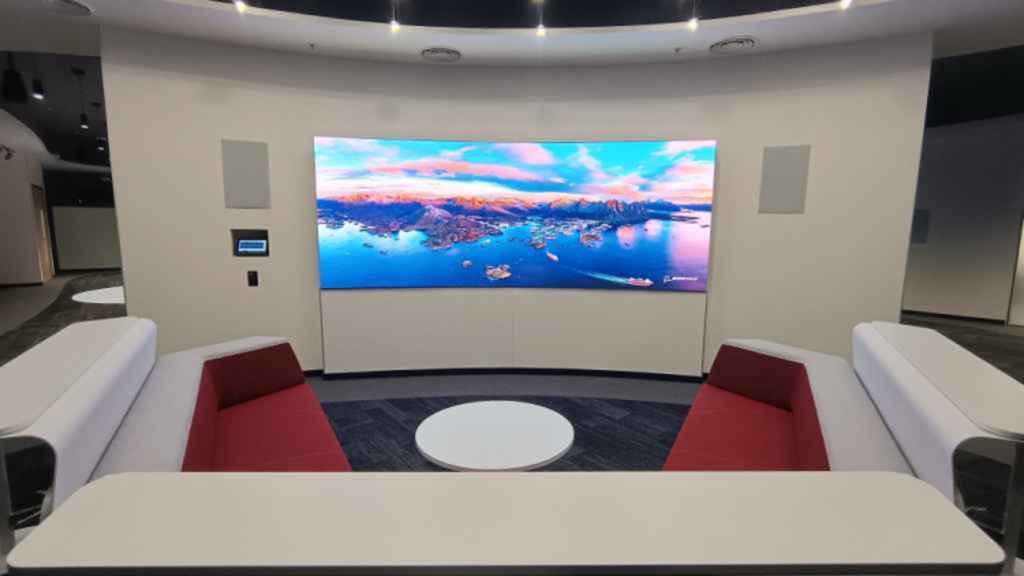
Technology plays an integral role in helping BIETC function, and through the course of this case study we will be exploring how Sigma AVIT crafted and commissioned solutions and systems that helped Boeing realise its vision.
Raymond V Soans from Sigma AVIT talks about the brief and requirements set forth by Boeing: “They wanted the technology to be smooth and easy to use for every person working in the organisation. Boeing’s main concern was around security, because the technology deployed was extensive. They wanted to make sure that the products selected were safe and reliable.”
There were multiple factors to account for and Sigma AVIT gave them due consideration. Soans expands: “We had to consider the fact that Boeing has multiple facilities around the globe. The people from Boeing will be travelling between these facilities so we had to make sure there was a consistent experience. And there is also the fact that the videoconferencing experience at BIETC needed to be coherent with the other facilities.”
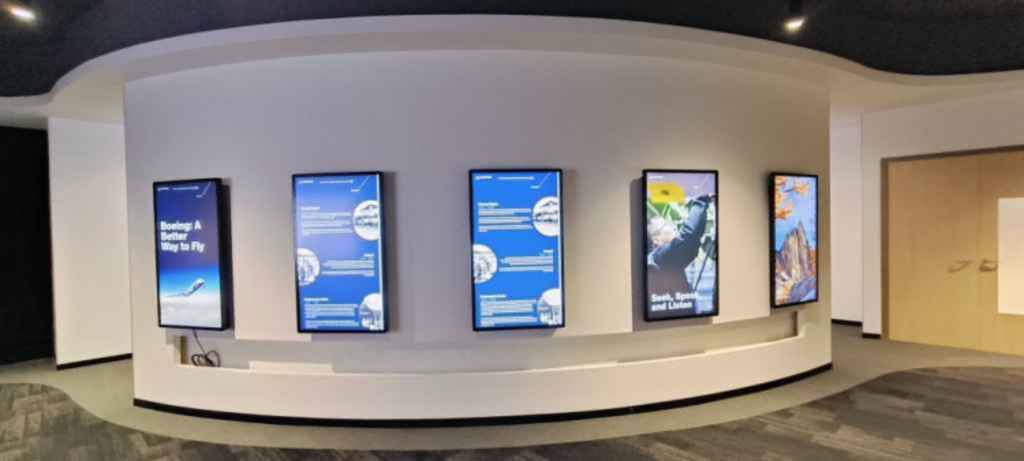
Soans sheds light on how input from Boeing translated into action: “Consistency of quality influenced the selection of products. Specifically, products and brands that were being used in the facilities in USA, that Boeing had already experienced, were prioritised for selection at the Indian facility as well. For example, Cisco was Boeing’s preferred videoconferencing platform and we went with this selection at BIETC as well. And this same thought process was applied to almost every other product selected. This had the benefit of users being familiar with the systems and the operators being familiar with managing and maintaining them.”
He adds: “The design was a collaborative process with the internal team at Boeing. They had to approve the designs and the products selected. And they had set parameters and standards which needed to be followed.”
Experience Centre
Crucial to achieving the aims of BIETC is the Experience Centre. Soans relays an interesting point related to the space: “The Experience Centre was actually a late-stage addition to the project. Boeing had an injection of funds come in, and we had to plan, design, and implement it in the last minutes. This was an interesting puzzle we had to solve but we are extremely proud of the end product.”
The Experience Centre comprises six unique zones.
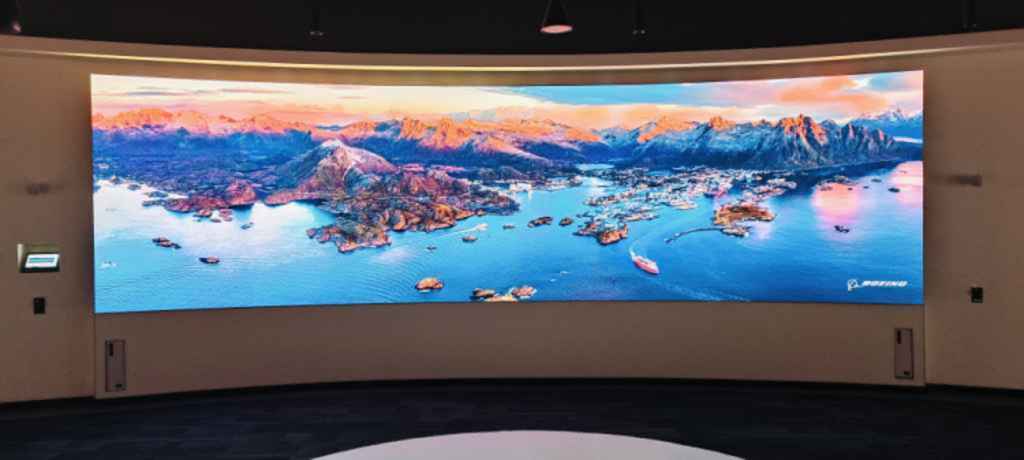
We start with Zone 1 which is the welcome area. The user journey commences with content displayed on a 100-in Planar interactive touch display paired with a Dell PC. Audio is delivered by two Genelec AIW26B in-wall speakers. The setup is designed to communicate complex technical information in an accessible and exciting manner.
In Zone 2, a curved Leyard TVF 1.2 active LED wall measuring 3.6m by 1.3m, complemented by a dedicated PC for content delivery, handles visuals. A Lightware wall-plate transmitter enables local presentations from laptops, while a Cyviz videowall processor manages the LED wall content. Two Genelec in-wall speakers enhance the immersive experience.

Upon entering Zone 3, visitors can interact with a detailed overview of selected aircrafts through five 55-in interactive displays from Planar, mounted in portrait mode. Each display is paired with a wired Shure headset (SRH440A) for a personalised audio experience. A dedicated thin client PC powers the content for each display.
Over in Zone 4, a curved active Planar TVF 1.2 LED wall measuring 7.2m by 2m serves as the focal point. A dedicated PC pushes content from a centralised location, while a Cyviz videowall processor manages the display. The high-quality audio experience is supported by a Biamp 11.2 surround system, which includes seven pendant speakers, four surface mount speakers, and two subwoofers. This zone showcases the evolution of Boeing aircraft technology and includes an engaging induction video that highlights the company’s culture, vision, and mission.
Sigma AVIT showcased the extent of its versatility and expertise as an integrator, by deploying a Vivitek DH765Z-UST projector to display visuals in Zone 5, where visitors can enjoy a unique experience with floor projection mapping. This zone aims to provide a real-time aircraft experience, allowing visitor to see the model from a bird's-eye view.
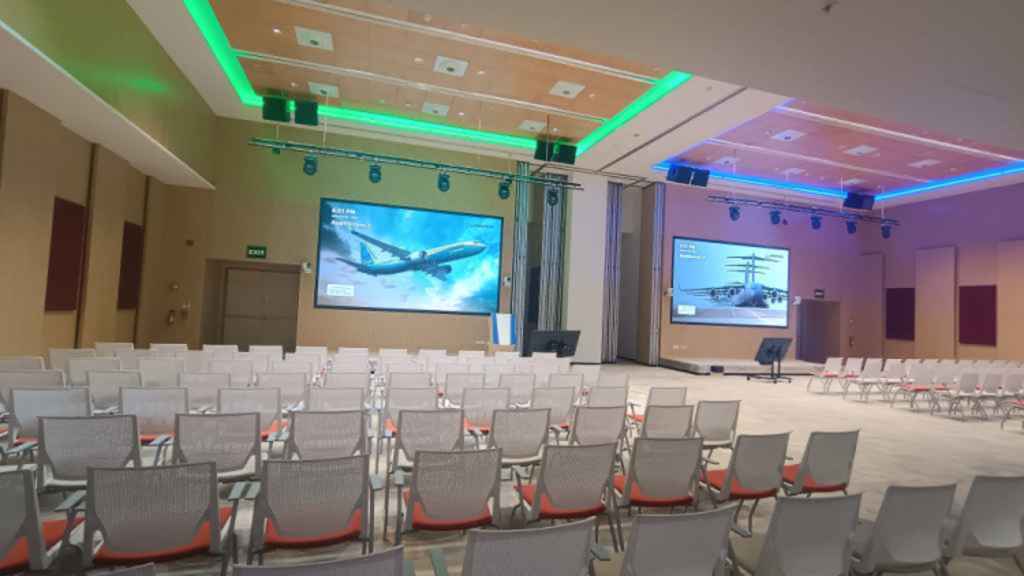
Finally, Zone 6 features an interactive kinetic display. Visitors can trigger this display by waving their hands, transforming their learning experience into a moment of discovery. Vivitek projectors with motion sensing capabilities showcase detailed video content, allowing visitors to explore the aircraft’s interior from cockpit to tail, aided by
3D glasses and a master wand controller. A dedicated PC supports content delivery, and two Genelec speakers enhance the audio experience.
The journey through the Experience Centre is capped with the Innovation Zone, a dynamic boardroom where executives can come together for strategic discussions. This space is equipped with MTC 105-in interactive displays that enable teams to visualise data and share insights effortlessly along with delivering content viewing and annotation capabilities.
On the backend, a T1V Thinkhub collaboration device is used and this powers the interactive canvas for brainstorming.
For content sharing, Sigma AVIT integrated two Crestron Fliptops on the table for wired connections, while the Crestron AirMedia AM-3200-WF-I allows for wireless content sharing. For traditional videoconferencing, a Cisco Kit Pro setup featuring a VC codec, quad camera, and Webex Room Navigator, has been installed.
Audio capabilities include two Shure ceiling tile microphones, supported by a Biamp Tesira Forte DSP for live audio signal processing. Additionally, six Biamp Desono CM660DTD ceiling speakers are pressed into service for audio playback.
At the Innovation Desk area, an additional MTC 105-in interactive display is supported by the T1V collaboration device and multisite license, promoting further collaboration. Two Biamp ceiling speakers provide audio support in this space as well.
A dedicated centralised area has been designed for the placement of AV equipment at the back of the Experience Centre. This includes a Lightware 24x24 HDMI matrix switcher for routing input and output sources, as well as a Cyviz controller to manage the AV equipment across all zones.
Auditorium
From the Experience Centre we jump to the other crown jewel of the BIETC facility, namely the auditorium.
Soans says: “The auditorium has been designed to operate as a whole or as smaller modular spaces, accommodating videoconferencing and live broadcasting requirements as per the direction of the client. To make this possible, it features two active LED walls from Planar measuring 4.8m by 2.7m. Videoconferencing is enabled by a Cisco Kit Pro, and wireless connectivity is provided by Crestron Airmedia. For live broadcast a Blackmagic Production Studio 4K serves as the heart of the system and there is a 24-in interactive monitor allowing for content preview and annotation. The technology in the auditorium makes it a completely flexible space that can adapt to the needs of any user.”

Staying with the visual systems, a Crestron 32x32 digital media modular matrix manages inputs and outputs, with all 32 ports in use.
Not neglecting the audio system, the auditorium has been graced with Bose FOH speakers, four subwoofers, and two stage monitor speakers. For speech, eight wireless handheld microphones, two head-worn microphones, two lavalier microphones, and two goose-neck microphones, all from the Shure ULX series, have been employed. And on the backend audio processing is handled by a Biamp DSP with 21 inputs and 20 outputs, incorporating a Dante interface card for audio-over-IP connectivity.
For live events and cultural activities, a digital mixing console is employed to manage audio signals for playback on the loudspeakers.
On the side of control, a Crestron Pro4 control processor is paired with a Crestron touch panel for user interaction. Partition sensors help in automatically detecting the mode of operation, whether the auditorium is used individually or in combination, and adjusting the functionality of the AV systems accordingly.
A dedicated AV control room is present which monitors individual or combined operations, the room features an Atem 1 M/E advanced control panel from Blackmagic for live video mixing, along with control of eight Panasonic PTZ cameras and video content management. The control room is equipped with six Dell SE 2219H 22-in monitors for previewing live event content. For larger gatherings, the AV content can also be broadcast to the cafeteria located on the first floor.
Cafeteria
Seeing that the cafeteria serves as an overflow space for the auditorium, it is logical to explore this space next. Following the local trend in India to pay special attention to these ‘third spaces’, the cafeteria is much more than just an area for recreation and socialising. This is also borne out in how the AV systems have been conceived and deployed in the space.
Matching the other spaces, the cafeteria has two 108-in Planar LED videowall displays for large scale content. These are augmented by three 65-in displays mounted on columns as repeater screens. A Crestron HDMI wall-plate transmitter and receiver facilitate wired presentation allowing content from laptops to be showcased on the Planar video- walls. For wireless connectivity, Crestron AirMedia units step in. A Lightware MX-FR17 HDMI matrix switcher manages inputs and outputs.
Videoconferencing duties are handled by a Cisco codec, while the connection between the cafeteria and auditorium is established with the help of a Lightware Ubex-PRO20-HDMI-F110 optical AV-over-IP system connected to a Lightware MX-FR17 card-based 17x17 digital crosspoint router frame, which includes a HDMI input card, an HDMI output card, and a TPS output board with PoE options. The output from the Cisco Kit Pro connects to the Lightware switcher, which in turn sends outputs to the cafeteria displays via receivers.
Understanding the cafeteria’s layout, three cameras are deployed for videoconferencing: two Cisco PTZ cameras on the front wall to capture participants and one Cisco P60 mounted on the rear ceiling to focus on the front. Using Lightware transmitters and receivers, video and control signals from the cameras extend to the codec. The far-end presentations are conducted through the dual 108-in LED videowall displays.
Training rooms
Starting to explore the more productivity-focused spaces at BIETC, we begin with the training rooms. These come in two types, with the classifications based on room orientation and furniture layout, while maintaining consistent application and product functionality.
The primary purpose of these training rooms is to enable videoconferencing and internal training sessions. They are equipped with 98-in LG 98UH5F-H displays for content viewing. In the Type-1 training room, a 65-in Samsung QM65B serves as a confidence monitor, allowing presenters to view their content while it is displayed on the main screen. Additionally, a Samsung QM32R monitor is installed on the presenter’s table for convenient access.
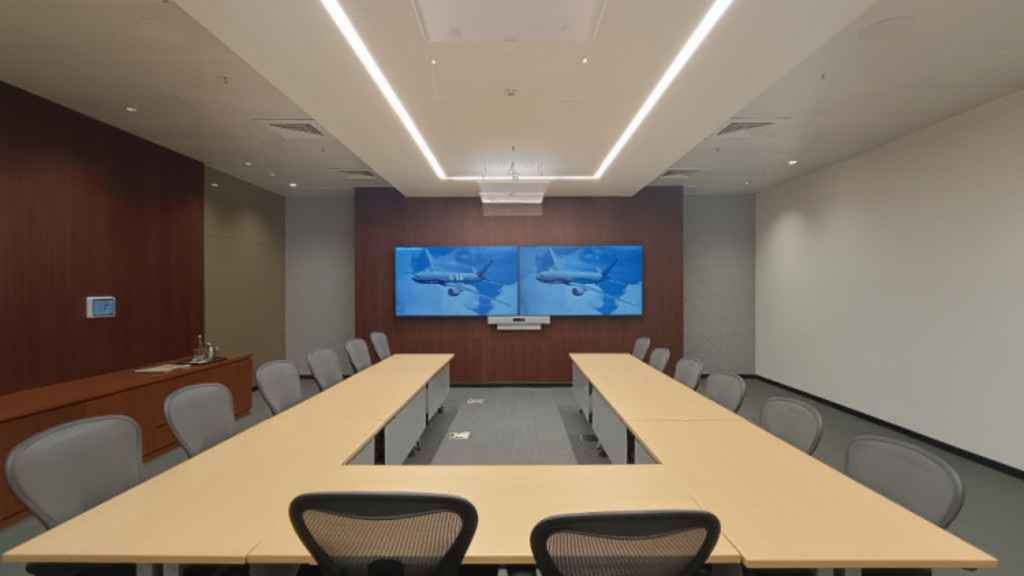
The systems also employ Crestron DM-MD16X16-CPU3 matrixes to route input and output sources when required. Wireless and wired content sharing capabilities are present.
The Cisco Kit Pro handles VC requirements and two Cisco PTZ cameras pick up visuals. The addition of a Cisco CS-T10-TS+ touch panel allows users to control calls.
To capture local participant audio, three Shure MXA910 ceiling array microphones are installed, along with one WL184-X lavalier microphone and two ULXD2/SM58 handheld wireless microphones for presentations. Crestron IC6LPT ceiling speakers and Biamp DSP complete the audio system.
The training rooms do vary in terms of equipment deployed, but the overarching design and concept does not differ.
Meeting spaces
As can be expected, the BIETC facility has a range of meeting spaces from huddle room, meeting rooms, to executive boardrooms and premium spaces.
The Executive Room makes a strong claim to being the crown jewel when it comes to meeting spaces. Designed to accommodate 21 people, a Leyard TVF 1.2 LED videowall measuring 4.88m by 1.37m serves as the main display. A Cyviz processor and controller are paired with the LED videowall.

A Lightware 16x16 matrix switcher serves as the heart of the visual system. Crestron Fliptop and AirMedia provided wired and wireless connectivity options. Cisco Kit Pro and a Cisco SpeakerTrack camera form the basis of the videoconferencing system.
On the side of audio, a Biamp DSP is the central component while a Shure MXA910 ceiling microphone picks up audio.
Over in the Briefing Room, Lightware and Crestron products make up the core of the switching. Crestron AMP-2210T power amplifier and speakers handle audio.
But what sets the Briefing Room apart is the Cisco WebEx Room Kit Plus which takes the videoconferencing experience to a whole new level. A Cisco Quad camera is installed between the dual 85-in displays on the front wall to capture participants in the room.
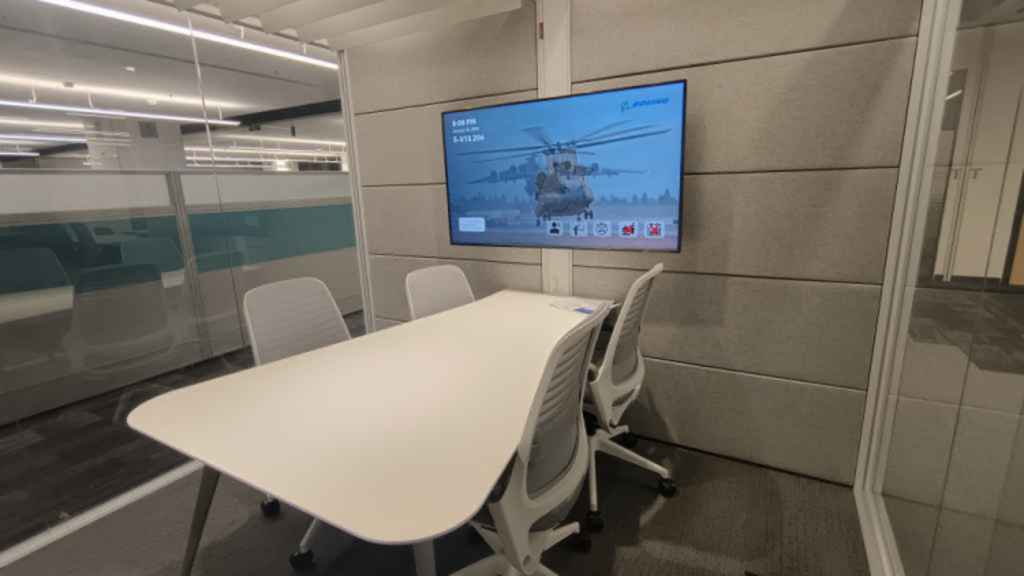
The output from the Cisco codec is routed to the dual 85- displays, allowing for local and remote presentations to be interfaced with in a manner not found anywhere else in the BIETC facility.
A further variety of meeting rooms cater to the VC needs of users. Crestron Fliptops and AirMedia provide wired and wireless connectivity as required in these spaces. Lightware switching manages inputs and outputs while Cisco handles videoconferencing duties.
In certain spaces where speed is of the essence, Jabra Speak 750 speakerphones provide plug-n-play functionality.
Regarding the meeting rooms, Soans comments: “The meeting spaces are sophisticated and classy. There was a great desire to keep things simple, but also provide flexibility. We’ve provided wired and wireless connectivity options for this, and plug-n-play functionality has also been prioritised.”
The BIETC facility was a sprawling project in terms of size, scope, and timelines. Dedication and hard work were crucial components that made the project a success.
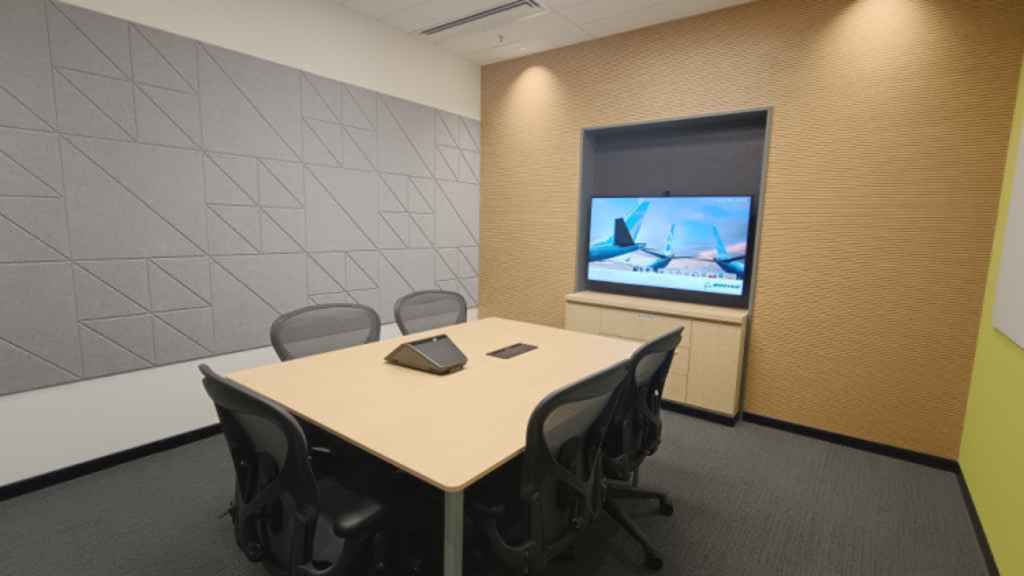
Soans brings the conversation to a close by recapping the challenges faced by Sigma AVIT and talks about how the integrator overcame them: “The challenge with the project was the extended duration. The BIETC facility was designed before the pandemic, and then the work progressed once the disruption ceased. Once we restarted, the realities of the workplace had changed and we had to go back to the drawing board before getting back to execution. In the meantime, the disruption to the global supply chain and the product shortage meant that availability of specified products was compromised which resulted in us having to find substitutes.
And on top of that, we had to contend with the overall time factor of the project. We had to be quick with turnaround, we had to manage lead times, there were a lot of moving parts, and we had to stay on top of everything until completion.”
Tech Spec
Video
Blackmagic Production Studio 4K
Cisco SpeakerTrack camera, Kit Pro setup, P60, PTZ cameras
Dell SE 2219H 22-in monitors, PCs
Crestron AM-3200-WF-I AirMedia, Fliptops, 32x32 digital media modular matrix
Cyviz XPO5 videowall processor
Jabra Speak 750 speakerphones
Leyard TVF 1.2 LED
LG 98UH5F-H displays
Lightware wall plate transmitters, 24x24 HDMI matrix switcher, Lightware Ubex-PRO20-HDMI, MX-FR17 HDMI matrix switcher, MX-FR17 card-based 17x17 digital crosspoint router frame, Ubex-PRO20- HDMI-F110 optical AV over IP system
MTC 105-in interactive displays
Panasonic AW-UE150 PTZ cameras
Planar URX100-ERO-T 100-in interactive touch display, URP55-T 55-in interactive displays, MGP 1.8 LED tiles, MGP012 LED tiles
Samsung QM65B, QM32R displays
T1V Thinkhub collaboration device
Vivitek DH765ZUST projector
Audio
Biamp MASK2, Sublime, P30DT, Desono speakers, Tesira Forte DSP
Bose AMM 112 speakers, subwoofers
Crestron AMP-2210T amplifier, speakers
Genelec AIW26B in-wall speakers
Shure SRH440A headsets, MXA910, MXA920 ceiling microphones, ULX series microphones
Yamaha QL5 mixer
Control
Blackmagic Atem 1 M/E advanced control panel
Cisco CS-T10-TS+ touch panels
Crestron Pro4 control processors, touch panels
Cyviz controllers